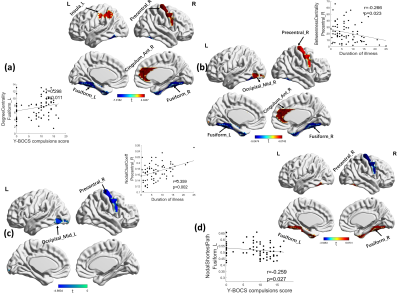Xue Li1, Hailong Li2, Lingxiao Cao2, Jing Liu2, Haoyang Xing1, and Xiaoqi Huang2
1Department of Physics, Sichuan university, chengdu, China, 2Huaxi Magnetic Resonance Research Centre (HMRRC), West China Hospital of Sichuan University, chengdu, China
1Department of Physics, Sichuan university, chengdu, China, 2Huaxi Magnetic Resonance Research Centre (HMRRC), West China Hospital of Sichuan University, chengdu, China
Application of
graph theory across multiple frequency bands in obsessive-compulsive disorder

Fig 1. Global properties of whole brain in
obsessive-compulsive disorder (OCD) and healthy control (HC) groups. The bars
showed significant between-group differences in the area under the curves (AUC)
of global metrics at slow2, slow3, slow4, slow5 and reference frequency bands
(0.01-0.08Hz). (a) γ, normalized clustering coefficient; (b) λ, normalized
characteristic path length; (c) σ, normalized small-world; (d) Global
efficiency; (e) Modularity, Q. * p<0.05, with t test. referB, reference
frequency band between 0.01 and 0.08 Hz.

Fig 3. The significantly
different nodal properties at slow3 band between the OCD patients and healthy
controls. (p<0.05, FDR corrected). (a) Degree centrality; (b) Betweenness centrality;
(c) Nodal clustering coefficient; (d) Nodal shortest path. Warm colors indicate
increase in OCD grooup, cool colors indicate decrease.